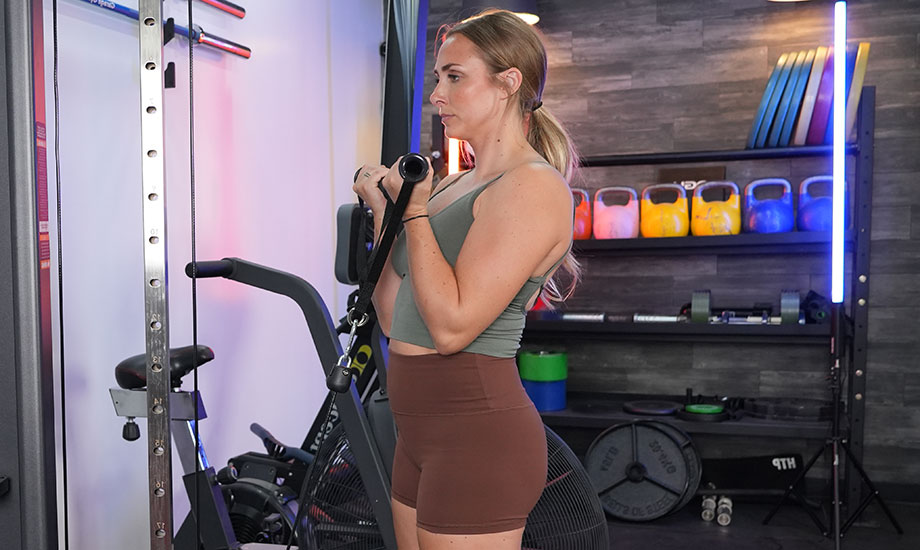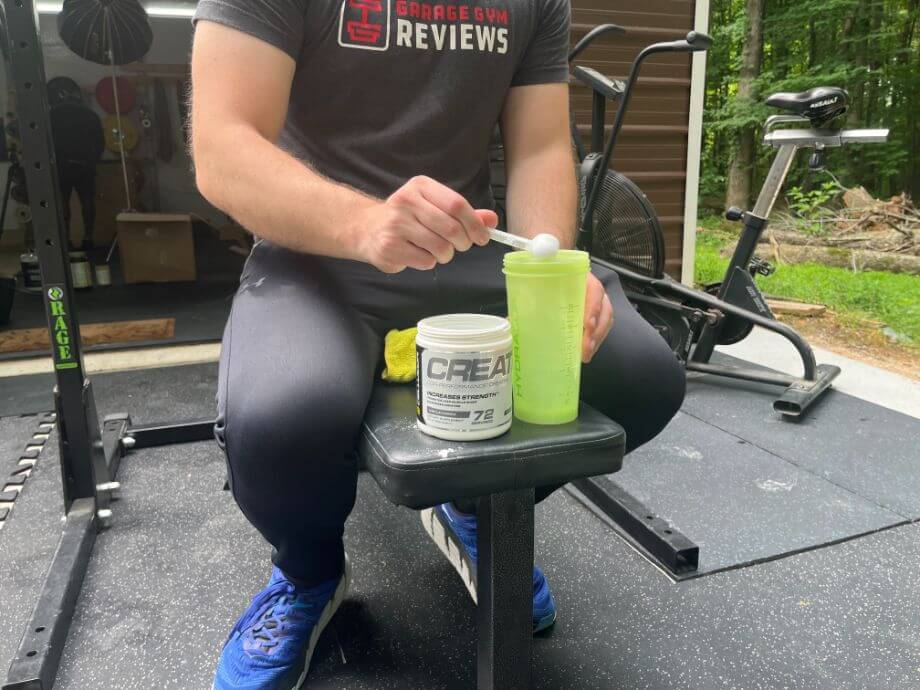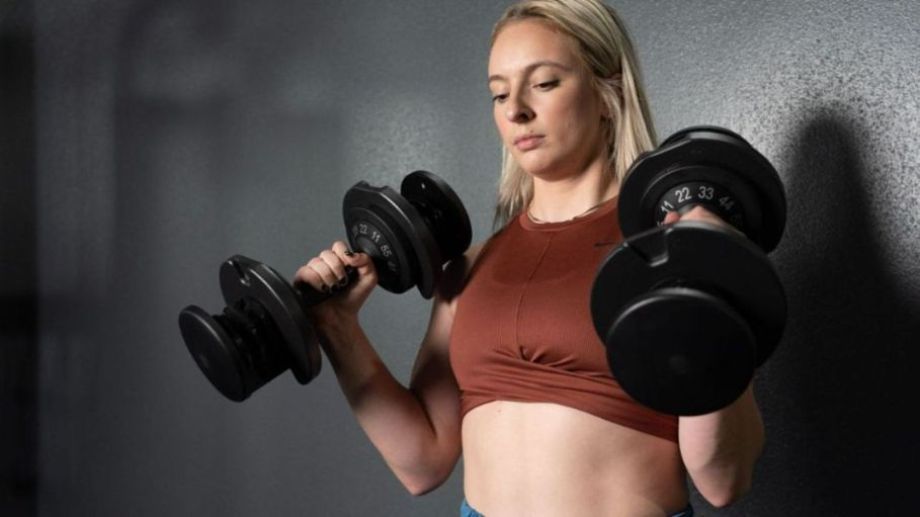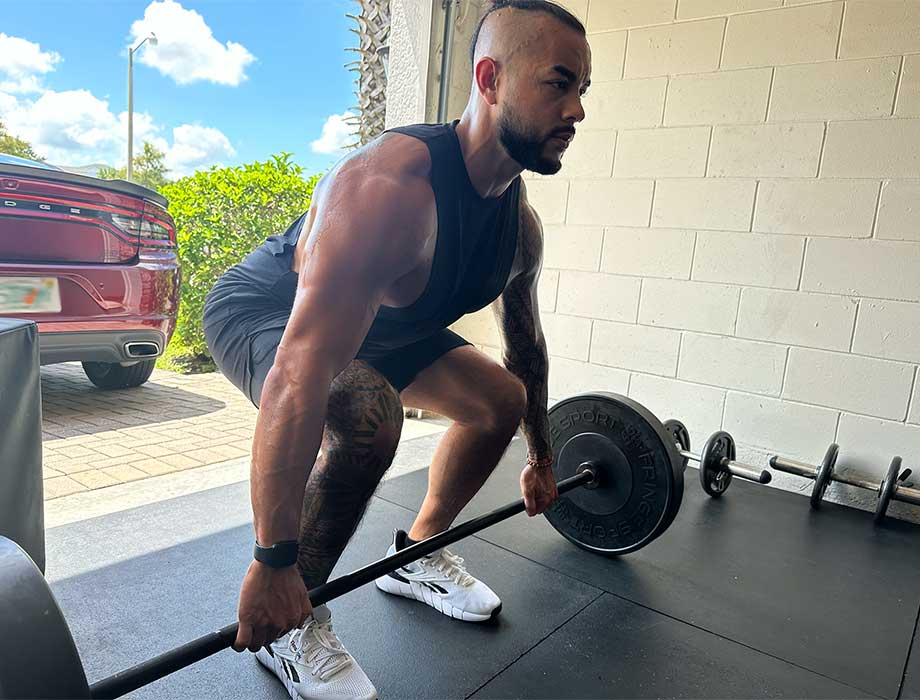Free weights are great for building muscle and strength, but that doesn’t mean they’re your only option.
The cable machine offers excellent exercise diversity, activating muscle groups throughout the entire body. This makes cable machine exercises an effective alternative to traditional free weight-based resistance training.
RELATED: Best Cable Machine for Home Gyms
Cable machines are especially beneficial for training upper body and arm muscles, like the biceps, triceps, and forearms. So, today, Amanda Capritto, CPT, CES, CNC, CF-L1, and GGR Senior Staff Writer, is sharing some of her favorite arm exercises using the cable machine.
Ready to give cable arm workouts a try? Here, you’ll get step-by-step instructions on how to set up and perform each exercise with proper form, as well as a sample cable arm workout to help you build strength, enhance hypertrophy, and improve muscular endurance.
Why Use a Cable Machine for Arms?
“Beginners often ignore the cable machine because, let’s face it, it’s scary,” says Amanda Capritto, CPT, CES, CNC, CF-L1. “It’s massive, has a bunch of cables and pulleys and attachments, and it seems like it’s only for elite athletes, but that’s not true at all! Everyone can benefit from using a cable machine!”
That’s because cable machines aren’t an identical substitution to the tried-and-true stimulus provided by traditional weight training. Cable machines provide dynamic resistance, which provides constant tension throughout the entire range of motion for an added challenge.
So, while some phases of the exercise will seem easier than others when using the best dumbbells, for example, you won’t get that same relief when using a cable machine.
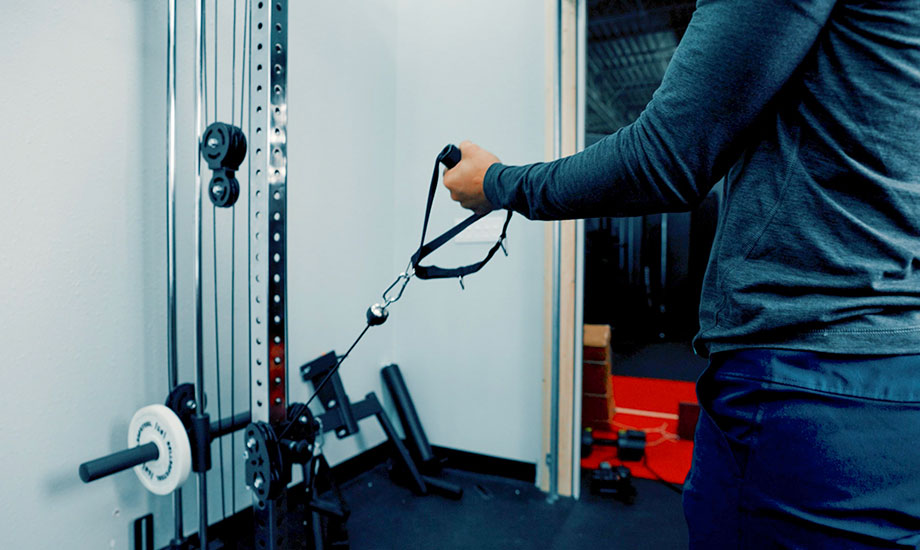
A 2010 study published in the Journal of Strength and Conditioning Research1 observed this phenomenon firsthand, noting that the “more uniformly distributed external resistance” created “greater average muscle tension…throughout the range of movement.” As a result, subjects were capable of performing less reps than they would using free weights—meaning they were hitting failure faster—indicating that the cable exercises provided greater muscle activation.
Another study, performed by the American Council of Exercise2 in 2014, shed more light on the topic, determining that the cable biceps curl ranks second in regards to biceps brachii activation. The exercise tied with the chin-up and was inferior only to the concentration curl.
RELATED: Cable Biceps Workout
So, the cable biceps curl and other cable exercises are capable of creating superior muscle activation that will ultimately lead to increased strength, endurance, and hypertrophy.
Cable Arm Exercises for Biceps
Looking to beef up those pythons? Build muscle and strength with these cable biceps exercises!
Cable Bicep Curl (Straight Bar)
Why we love it: The American Council of Exercise (ACE) found that the cable bicep curl provides the best biceps muscle activation next to the concentration curl, meaning it’s the best cable exercise for your biceps workout.
How to do it:
- Set the cable machine to the low pulley position and attach the straight bar attachment.
- Select the desired amount of weight and grip the handle with an underhand grip.
- Stand facing the machine with your feet shoulder-width apart and your knees slightly bent.
- Slowly curl the bar toward your shoulders, squeezing your biceps at the top.
- Slowly lower the bar to the starting position, keeping your elbows pinned to your sides.
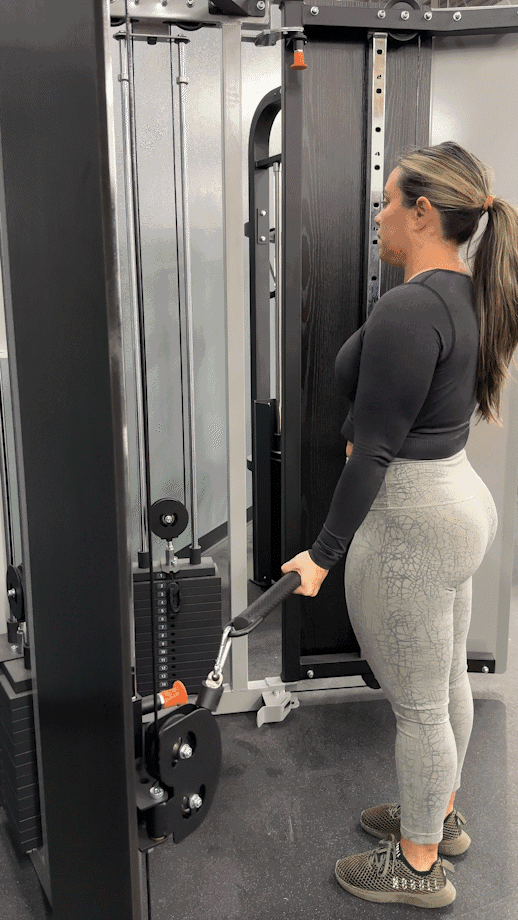
Cable Hammer Curl (Rope Attachment)
Why we love it: “You’ll get a lot of bang for your buck with standard curls, but hammer curls shift the emphasis from the short head to the long head of the bicep,” says Amanda Capritto, CPT, CES, CNC, CF-L1. “Working them both is beneficial for both improving strength and ensuring even growth of the muscle.”
How to do it:
- Set the cable pulley to the lowest position and attach the rope attachment.
- Select the desired amount of weight and grip the ends of the rope handle with both hands using a neutral grip, meaning you’ll have your palms facing each other.
- Facing the machine with your feet shoulder-width apart, slowly curl the rope toward your shoulders. Squeeze your biceps at the top.
- Slowly lower the attachment back down.
RELATED: How to Do Hammer Curls
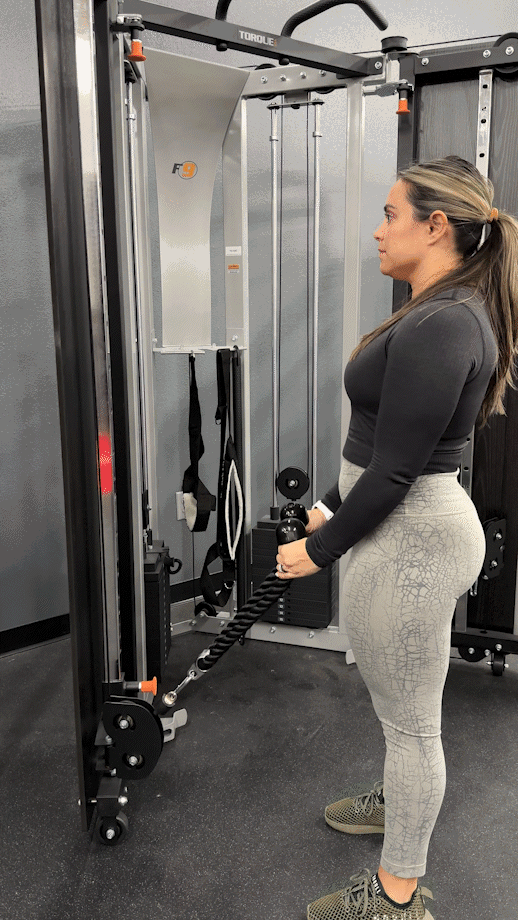
Single-Arm Cable Curl
Why we love it: Performing bilateral movements results in some level of compensation; the stronger side typically picks up the slack of the weaker side. You can nip this in the bud by converting the cable curl into a unilateral cable curl.
How to do it:
- Set the cable machine to the low position and attach a single-handle attachment.
- Face the machine and grip the handle with an underhand grip.
- Curl the handle toward your shoulder, then slowly bring it back down.
- Repeat for the desired number of reps, then switch sides and repeat the set.
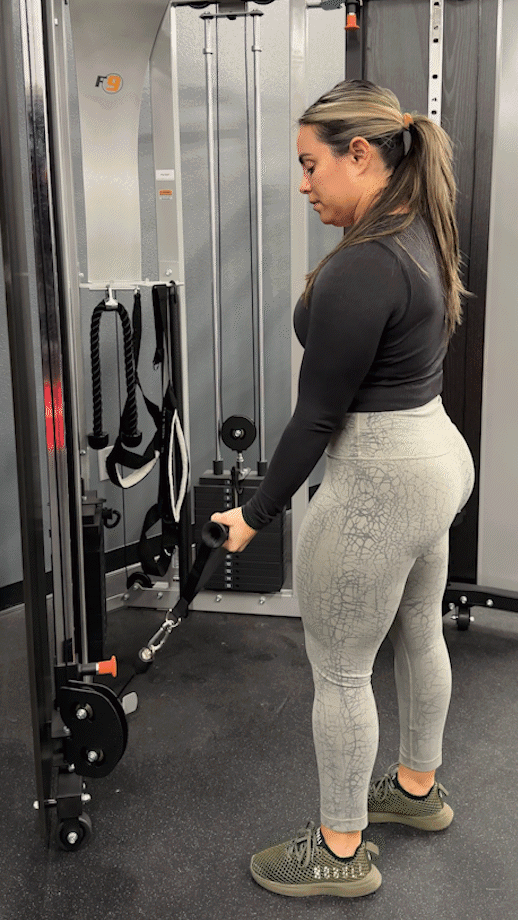
Supine Cable Curls
Why we love it: “Lying supine (facing up) places your shoulders against a flat bench, so you don’t wind up using them unintentionally to assist the bicep curl movement,” says Amanda. “You won’t always know if your shoulders are moving forward or back while standing, but from this position, you’ll definitely know if they start coming off the bench, and then you can correct.”
How to do it:
- Set up a weight bench so that it’s perpendicular to the cable machine.
- Set the machine to the high pulley position and attach the straight bar attachment.
- Lie with your head near the weight stack and grip the handle with an underhand grip.
- Pull the bar toward your face using only elbow flexion.
- Squeeze your biceps at the bottom of the movement, then slowly guide the cable back up.
RELATED: Best Weight Bench
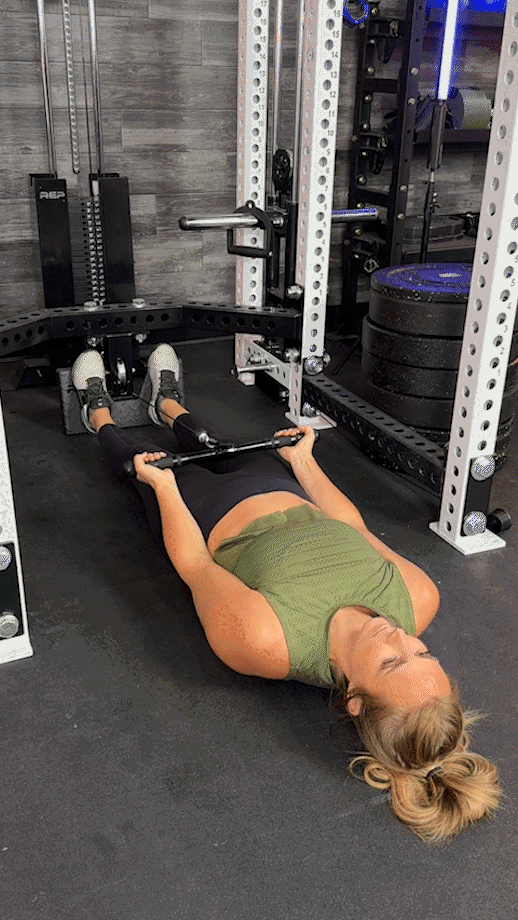
Cable Preacher Curls
Why we love it: Using a preacher bench or preacher pad to stabilize the elbow joint is another way to ensure you keep the bicep as virtually the only muscle working during the curl.
How to do it:
- Set the cable machine to the low position and attach a straight bar attachment.
- Position a preacher bench so it’s facing the cable machine and have a seat. If you don’t have one, an incline bench set to approximately 45-degrees should work, but you’ll need to stand to recreate the motion.
- Extend your arms across the pad and grip the handle with an underhand grip.
- Curl the bar attachment toward your shoulders, keeping your elbows against the pad or bench.
- Squeeze your biceps at the top, then slowly lower back down.
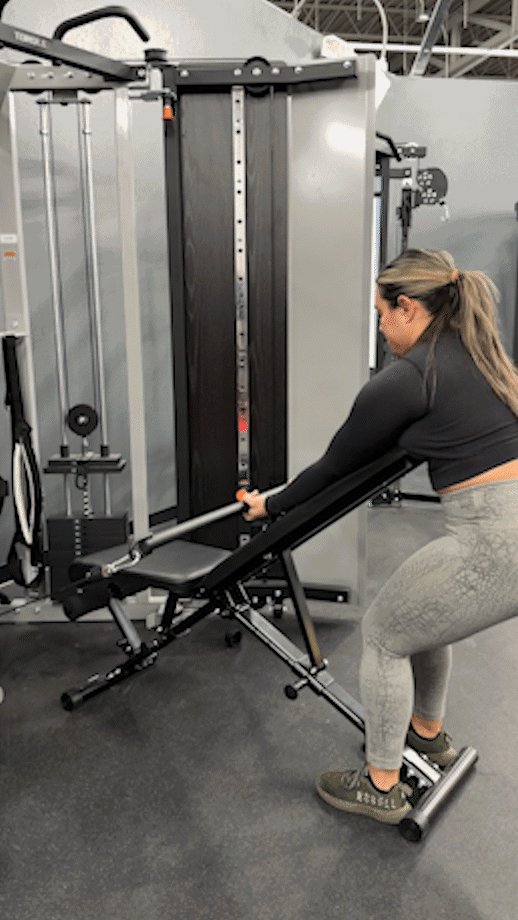
Cable Arm Exercises for Triceps
Most people focus on building bigger biceps, but the triceps actually account for more than half the real estate as far as your upper arm muscles go.
So, give equal time training to building your triceps “horseshoe”!
Straight Bar Push-Downs
Why we love it: The tricep pushdown is one of the best tricep exercises. Using the straight bar allows you to move heavier weights and emphasizes the long head of the triceps.
How to do it:
- Set the cable machine to the high position and attach the straight bar attachment.
- Grip the handle with an overhand grip and push it straight down.
- Squeeze your triceps at the end of the movement, then slowly bring the handle back up.
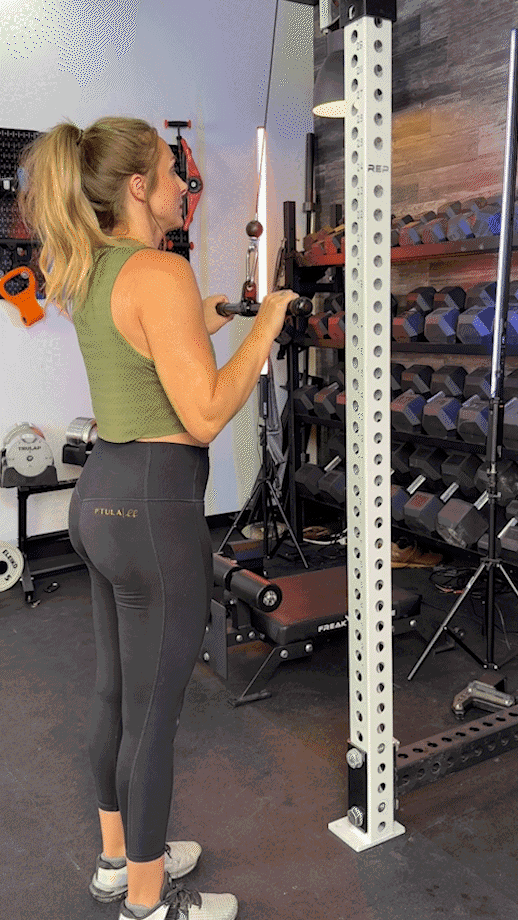
Rope Attachment Push-Downs
Why we love it: “Using the rope attachment for your triceps pushdown provides more muscle activation due to an increased range of motion and the neutral grip,” says Amanda. “Using the rope also emphasizes the lateral head of the triceps, so try rotating between the straight bar and rope for a truly comprehensive tricep workout routine!”
How to do it:
- Set the cable machine to the high position and attach the rope attachment.
- Grip the handles using a neutral grip, then push it down by extending your elbows. Unlike the straight bar, the rope allows you to bring your hands all the way to your sides.
- Squeeze the triceps, then slowly return to the starting position.
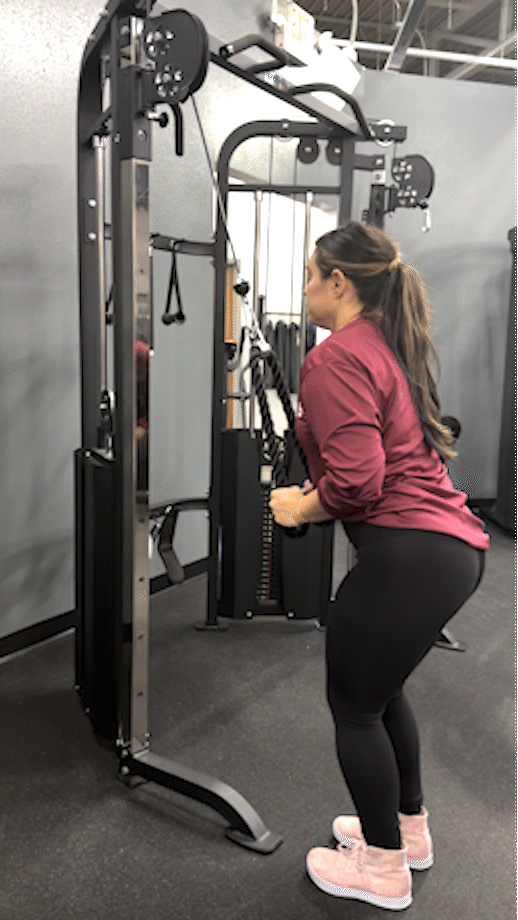
Overhead Tricep Extension (Rope Attachment)
Why we love it: According to a 2023 study in the European Journal of Sport Science3, “cable elbow extension training should be performed in the overhead…position [to maximize] muscle hypertrophy of the triceps brachii.” That’s because this positioning emphasizes the long head of the triceps, which “growing evidence suggests…promotes muscle hypertrophy”
How to do it:
- Set a cable machine to the low pulley position and attach the rope attachment.
- Grip the attachment using a neutral grip and stand with your back to the machine.
- Lean forward slightly, keeping your back straight and core tight, and step forward to enter a staggered split stance. The rope should now be held right behind your head.
- Extend your elbows, bringing the rope directly overhead.
- Squeeze the triceps, then slowly return to the starting position.
RELATED: Hypertrophy Workout
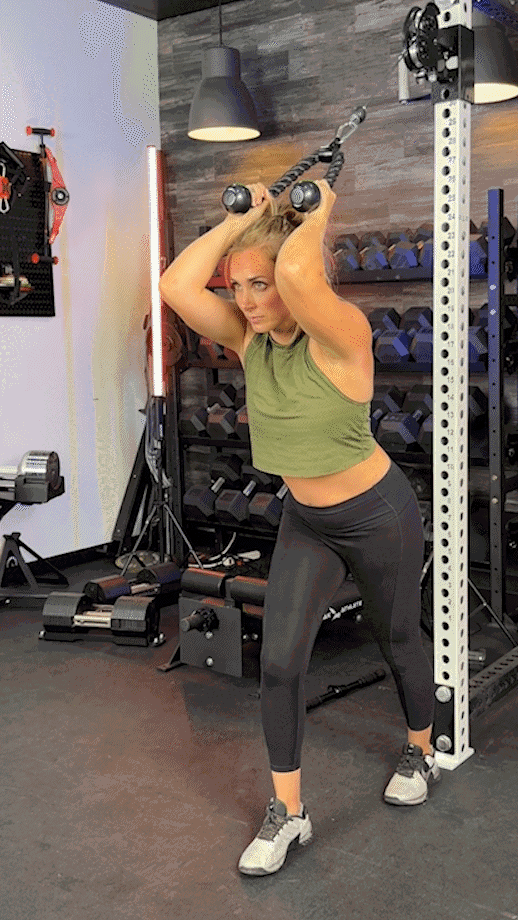
Single-Arm Overhead Tricep Extension
Why we love it: Converting your standard overhead tricep extension to a single-arm version takes away your ability to compensate. You’ll get equal work done and correct imbalances doing the unilateral version.
How to do it:
- Set a cable machine to the low pulley position and attach the single handle attachment.
- Grip the attachment stand with your back to the machine.
- Lean forward and enter a staggered split stance.
- Extend your elbow, bringing the handle overhead.
- Squeeze your tricep, then return to the starting position.
- Repeat as needed, then switch sides and repeat the set.
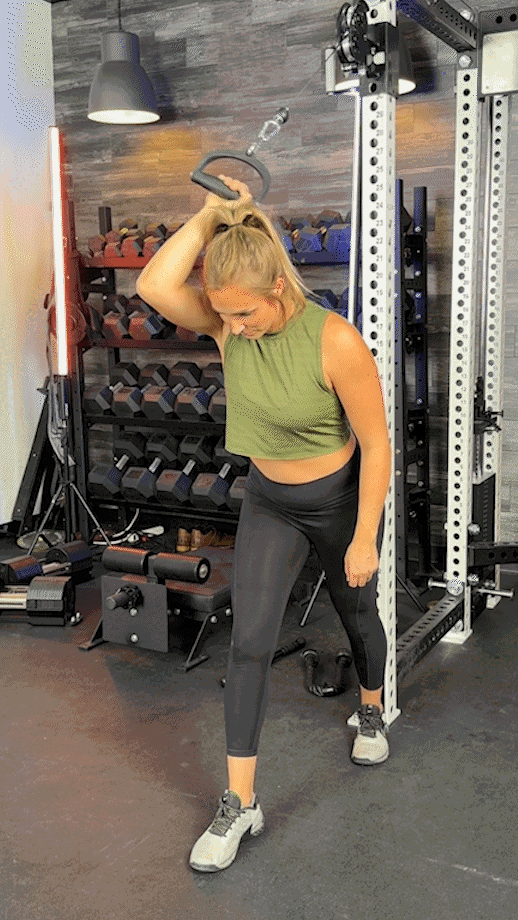
Supine Cable Tricep Extension
Why we love it: “Think of [the supine cable tricep extension] as a reverse skullcrusher,” says Amanda. “The positioning is nearly identical, but now the starting position has the bar in front of your face. You’re fighting to move the weight against the tension of the cable rope rather than gravity.”
RELATED: How to Perfect the Skull Crusher Workout
How to do it:
- Set up a weight bench so that it’s perpendicular to the cable machine.
- Set the machine to the low pulley position and attach the straight bar attachment.
- Lie with your head near the weight stack and grip the handle with an overhand grip.
- Push the bar away from your face using only elbow flexion.
- Squeeze your triceps, then slowly guide the bar back down.
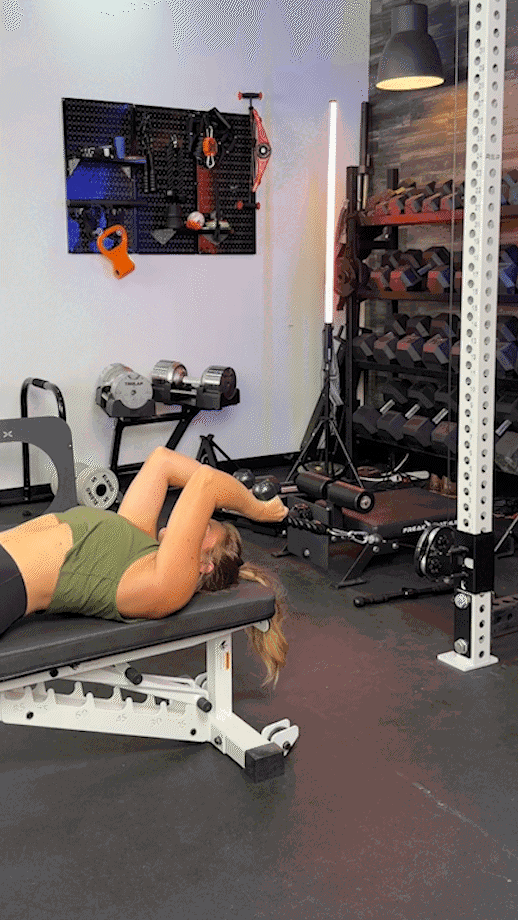
Sample Cable Arm Workout
“These exercises will engage your arm muscles effectively, but how you program the workout will depend on your goals,” says Amanda Capritto, CPT, CES, CNC, CF-L1, and GGR Senior Staff Writer. “For example, someone who’s interested in hypertrophy or bodybuilding will prefer an 8 to 12 rep range and moderately heavy weights, while strength training athletes are better suited to low reps, between 1 and 5, at a much heavier weight.”
RELATED: Bodybuilding Workouts
If you’re looking for a workout more catered to your strength or growth goals, consider working with a certified personal trainer, coach, or other qualified fitness professional.
Ready to rock? Here’s our recommended cable arm workout for general fitness purposes.
| Exercise | Sets | Reps |
| Standing Bicep Curl | 3 to 6 | 6 to 12 |
| Rope Pushdowns | 3 to 6 | 6 to 12 |
| Hammer Curl (Rope) | 3 to 6 | 6 to 12 |
| Overhead Tricep Extension | 3 to 6 | 6 to 12 |
| Supine Bicep Curl | 3 to 6 | 6 to 12 |
| Supine Tricep Extension | 3 to 6 | 6 to 12 |
RELATED: How Many Reps to Build Muscle
Cable Arm Workout: Final Thoughts
The cable machine isn’t just an alternative to your standard barbell-, dumbbell-, and kettlebell-based workouts; it’s an entirely different kind of resistance that’ll provide a new stimulus to your muscles.
RELATED: Best Kettlebells
The cable machine is also useful for general resistance training, breaking through plateaus, and providing diversity to your routine by staving off boredom.
Don’t let that behemoth of a machine scare you off. The cable machine is your friend, and these cable arm workouts are sure to help you get the results you’ve been working hard for.
Cable Arm Workouts: FAQs
Are cables good for arms?
Absolutely. Cable machines enable you to perform the same movement patterns as most free weight exercises while providing a different type of resistance, making it an overall effective way to target, strengthen, and build your arm muscles.
How do you use a cable machine for arms?
“The key is knowing where to set the cable pulley,” says Amanda Capritto, CPT, CES, CNC, CF-L1, and GGR Senior Staff Writer. “For example, if you already know how to do the overhead triceps extension, you need to know and understand that, in order to create a similar stimulus using the cable machine, that pulley has to be set low, so you’re fighting to bring the handle overhead. It’s almost the reverse of the free weight version, but the movement pattern is nearly identical.”
How do you hit your biceps with a cable machine?
Think about how you hit your biceps without a cable machine. You grab a barbell or dumbbell and curl it toward your body, essentially isolating your biceps muscle. With a cable pulley, it’s the same movement pattern, except now you’re using a machine for resistance instead of a dumbbell.
RELATED: 7 Best Dumbbell Curl Variations
While cable machines seem intimidating, they’re actually quite simple and, once you get the hang of them, you’re bound to love them as we do here at GGR! Good luck, fitness fam!
References
1. García-López D, Herrero AJ, González-Calvo G, Rhea MR, Marín PJ. Influence of “in series” elastic resistance on muscular performance during a biceps-curl set on the cable machine. J Strength Cond Res. 2010;24(9):2449-2455. doi:10.1519/JSC.0b013e3181e3482f
2. Young, M.S., S., Porcari, Ph.D., J. P., Camic, Ph.D., C., Kovacs, Ph.D., A.; Foster, Ph.D., C. Ace Study Reveals Best Biceps Exercises. ACE. ProSource™: August 2014
3. Maeo S, Wu Y, Huang M, et al. Triceps brachii hypertrophy is substantially greater after elbow extension training performed in the overhead versus neutral arm position. Eur J Sport Sci. 2023;23(7):1240-1250. doi:10.1080/17461391.2022.2100279


